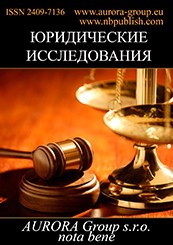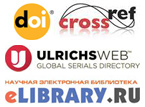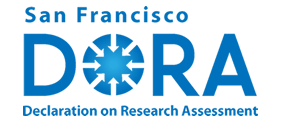Reference:
Voykova, N.A., Moreeva, S.N., Matsaeva, T.V. (2025). Internet sales of potent substances: regulation and gaps in legislation. Legal Studies, 5, 1–21. https://doi.org/10.25136/2409-7136.2025.5.73904
Read the article
First Peer Review:
Second Peer Review:
Third Peer Review:
|
EDN: ADEHFM

|
Abstract:
The subject of the study is the legal mechanisms aimed at regulating the process of remote sales of potent substances and poisonous chemical compounds through the use of the Internet. The article sequentially analyzes the provisions of current Russian legislation in the field of circulation of toxic substances, examines existing tools aimed at ensuring information security, and explores the possibility of their application to the remote sale of dangerous and potentially harmful substances through online platforms. Special attention is paid to the powers of the Federal Service for Supervision in the Sphere of Telecom, Information Technologies and Mass Communications (Roskomnadzor), as well as the identification of gaps in these powers. The risks arising from the unrestricted access to poisonous compounds in the virtual space are considered, and legal tools for preventing and suppressing such violations are proposed. The authors used the following methods: Comparative legal method (within the framework of analyzing normative acts regulating the circulation of potent and toxic substances in Russia); Systemic method (to identify gaps in legislation and assess the effectiveness of existing control mechanisms); Technical-legal method. The empirical part of the study was carried out through monitoring of Internet resources and inquiries to state authorities, analysis of judicial practice. The study emphasizes the importance of developing stricter measures of legal regulation that would prevent the circulation of potent substances and poisons, as well as toughening liability for violations of the relevant norms. Based on the above, the following recommendations can be formulated. 1. Legislative Improvements: Clarify the concepts of "potent" and "toxic substances" in regulatory acts to ensure uniform application of the law; Amend the Federal Law "On Information…" by including websites disseminating information on the sale of toxic substances, the illegal circulation of which is punishable under Art. 234 of the Criminal Code, in the list of resources subject to blocking without a court decision (by analogy with narcotics). 2. Strengthening Control and Enhancing Interagency Cooperation: Grant relevant authorities (Roskomnadzor and the Ministry of Internal Affairs) the authority to monitor and suppress online sales of dangerous substances, including the Darknet; Create a unified database of prohibited substances and their analogs to promptly identify new trafficking schemes; Enhance cooperation with customs and postal services to intercept shipments containing poisons.
Keywords:
toxicological aspects, law enforcement activities, health threats, legal liability, cyber threats, administrative law, criminal legislation, illegal trade, e-commerce, Toxic substances
JUDICIAL POWER
Reference:
Gaivoronskaia, L.V. (2025). The problems of satisfying the petition on the bias of the jury. Legal Studies, 5, 22–35. https://doi.org/10.25136/2409-7136.2025.5.73664
Abstract:
Due to the legislator's very concise legal regulation of the concept of tendentious composition of jurors and the lack of criteria that would allow satisfying the petition for the dissolution of the board, the scientific literature is replete with contradictory discussions on the necessity of the existence of such an institution, and judicial practice is very few and there is no uniformity. Therefore, the subject of research in this article is the concept of bias in the composition of jurors, the search for criteria by which the totality of the factual circumstances of a particular criminal case and the existing composition of jurors would satisfy the concept of bias. The author attempts to analyze specific examples of judicial practice, compare them with the actual circumstances of the case under consideration and deduce from them an understanding of the bias of the jury panel, as well as the criteria by which such a request could be satisfied. The author uses methods such as induction, deduction, observation, comparison, analysis and generalization in the research process. Since the practice of satisfying petitions for the bias of the jury is very limited, today in practice it is difficult to understand what needs to be indicated in such a petition for a favorable outcome. Therefore, the novelty of this study lies in the fact that the author has tried to study judicial practice and present his own conclusions on the subject of the content of such a petition: it is not enough to point out only the deficiency on the basis of gender, race, nationality or profession of the formed panel of jurors. The issue of its bias is studied in the context of the specific factual circumstances and features of the criminal case under consideration. That is, a biased panel of jurors based on the fact that most of the jurors are women will be relevant only in cases of sexual crimes directly related to the relationship between the sexes. It would not be convincing to file such a motion, for example, in a fraud case.
Keywords:
The college's prejudice, the objective verdict, trial by jury, petition for bias, uniformity of the jury composition, formation of the jury panel, dissolution of the jury, statement of bias, The jurors, bias
 This work is licensed under a Creative Commons Attribution-NonCommercial 4.0 International License.
This work is licensed under a Creative Commons Attribution-NonCommercial 4.0 International License.
 Eng
Eng











 © 1998 – 2025 Nota Bene. Publishing Technologies. NB-Media Ltd.
© 1998 – 2025 Nota Bene. Publishing Technologies. NB-Media Ltd.




